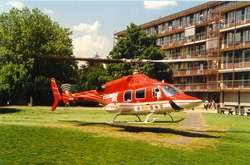Wed, Jun 16, 2010
Main Rotor And Tail Boom Separated From Bell 222U Over
Midlothian, TX
 The NTSB has issued a preliminary report in an accident
involving a Bell 222U helicopter owned and operated by CareFlite of
Grand Prairie, TX. The report indicates that the aircraft broke up
while on a post-maintenance flight at about 600 feet AGL.
The NTSB has issued a preliminary report in an accident
involving a Bell 222U helicopter owned and operated by CareFlite of
Grand Prairie, TX. The report indicates that the aircraft broke up
while on a post-maintenance flight at about 600 feet AGL.
NTSB Identification: CEN10FA291
14 CFR Part 91: General Aviation
Accident occurred Wednesday, June 02, 2010 in Midlothian, TX
Aircraft: BELL 222, registration: N515MK
Injuries: 2 Fatal.
This is preliminary information, subject to change, and may
contain errors. Any errors in this report will be corrected when
the final report has been completed.
On June 2, 2010 at approximately 1400 central daylight time, a
Bell 222U, multi-engine helicopter, N515MK, was destroyed after
impacting terrain near Midlothian, Texas. The airline transport
rated pilot and the mechanic, who were the only occupants,
sustained fatal injuries. The helicopter was owned and operated by
CareFlite, Grand Prairie, Texas. Visual meteorological conditions
(VMC) prevailed at the time of the accident and a company flight
plan had been filed for the Title 14 Code of Federal Regulations
Part 91 return to service flight following maintenance that had
been performed. The helicopter had departed the Grand Prairie
Municipal Airport (GPM) Grand Prairie, Texas at approximately 1352,
and had planned to return to GPM airport.

File Photo
The helicopter was in cruise flight at approximately 600 feet
above ground level (AGL) when several witnesses saw the tail boom
and the main rotor system separate from the helicopter. The
fuselage was destroyed in an immediate post-impact fire. The main
rotor mast separated just below the head. The main rotor system
including the hub and blade assembly, pitch change links, and
walking beam assembly remained connected to the swash plate
assembly and impacted terrain approximately 200 feet northeast of
the main wreckage. The entire tail boom assembly separated just aft
of the fuselage and impacted terrain approximately 400 feet
northeast of the main wreckage.
The wreckage was removed to a secure storage facility for
continued investigation.
More News
Aero Linx: Aviators Code Initiative (ACI) Innovative tools advancing aviation safety and offering a vision of excellence for aviators. The ACI materials are for use by aviation pra>[...]
Make Sure You NEVER Miss A New Story From Aero-News Network Do you ever feel like you never see posts from a certain person or page on Facebook or Instagram? Here’s how you c>[...]
From 2016 (YouTube Edition): Who You Gonna Call When You Have a Rocket Engine that Needs a Spacecraft? While at EAA AirVenture 2016, ANN CEO and Editor-In-Chief, Jim Campbell, sat >[...]
"In my opinion, if this isn't an excessive fine, I don't know what is... The odds are good that we're gonna be seeking review in the United States Supreme Court. So we gotta muster>[...]
Expedite Used by ATC when prompt compliance is required to avoid the development of an imminent situation. Expedite climb/descent normally indicates to a pilot that the approximate>[...]
 ANN's Daily Aero-Linx (04.30.25)
ANN's Daily Aero-Linx (04.30.25) ANN FAQ: Turn On Post Notifications
ANN FAQ: Turn On Post Notifications Classic Aero-TV: Agile Aeros Jeff Greason--Disruptive Aerospace Innovations
Classic Aero-TV: Agile Aeros Jeff Greason--Disruptive Aerospace Innovations Aero-News: Quote of the Day (04.30.25)
Aero-News: Quote of the Day (04.30.25) ANN's Daily Aero-Term (04.30.25): Expedite
ANN's Daily Aero-Term (04.30.25): Expedite




